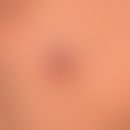Synonym(s)
HistoryThis section has been translated automatically.
DefinitionThis section has been translated automatically.
Rare, benign, subcutaneously palpable, clinically symptom-free, solid tumour (node), predominantly located in the scapular region.
You might also be interested in
Occurrence/EpidemiologyThis section has been translated automatically.
EtiopathogenesisThis section has been translated automatically.
ManifestationThis section has been translated automatically.
LocalizationThis section has been translated automatically.
Mainly scapula area located below the fascia (> 80% of cases), also lumbar region, upper arm, hip and foot.
ClinicThis section has been translated automatically.
HistologyThis section has been translated automatically.
Tumorous structural change of the collagenous connective tissue localized in the dermis and spreading to the subcutaneous fatty tissue. There are broad, cell-poor, lumpy collagenous ligaments with a staining behaviour like elastotic material. These are partly wavy, partly fragmented and fluoresce greenish. Isolated islands of fatty tissue.
Immunohistochemistry: Numerous myofibroblasts of the VAD-type, some CD34- and S100-positive cells.
Differential diagnosisThis section has been translated automatically.
TherapyThis section has been translated automatically.
Progression/forecastThis section has been translated automatically.
LiteratureThis section has been translated automatically.
- Alberghini M et al (2003) Elastofibroma associated with high grade leiomyosarcoma of the soft tissues: a light and ultrastructural study of one case. J Submicrosc Cytol Pathol 35: 43-48
- Alberghini M et al (2004) Histochemical and ultrastructural study of an elastofibroma dorsi coexisting with a high grade spindle cell sarcoma. Eur J Histochem 48: 173-178
- Dalal A (2003) Sonographic detection of elastofibroma dorsi. J Clin Ultrasound 31: 375-378
- Guha AR et al (2004) Elastofibroma dorsi--a case report and review of literature. Int J Clin Pract 58: 218-220
- Jarvi OH, Saxen AE (1961) Elastofibroma dorsi. Acta Pathol Microbiol Scand 144: 83-84
- Kara M (2002) Bilateral elastofibroma dorsi: proper positioning for an accurate diagnosis. Eur J Cardiothorac Surgery 22: 839-841
- Muller LP et al (1999) Bilateral elastofibroma dorsi. Surgeon 70: 1357-1360
- Nishio JN et al (2002) Gain of Xq detected by comparative genomic hybridization in elastofibroma. Int J Mol Med 10: 277-280
- Nishida A et al (2003) Bilateral elastofibroma of the thighs with concomitant subscapular lesions. Skeletal radiol 32: 116-118
Incoming links (1)
Elastofibroma dorsi;Outgoing links (5)
Excision; Keloid (overview); Lipoma (overview); Liposarcoma; Pseudoxanthoma elasticum;Disclaimer
Please ask your physician for a reliable diagnosis. This website is only meant as a reference.




